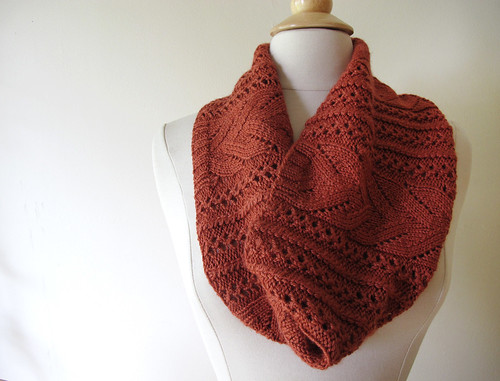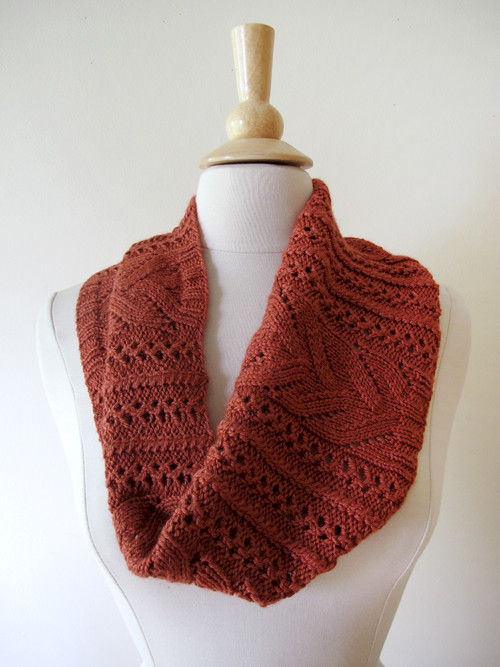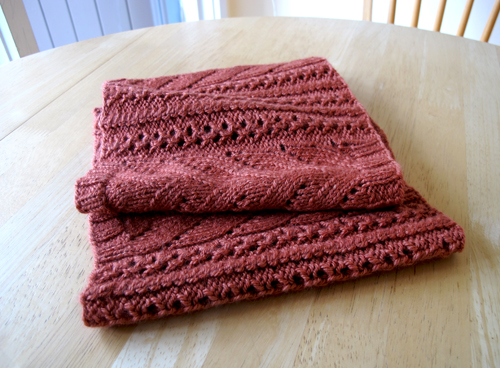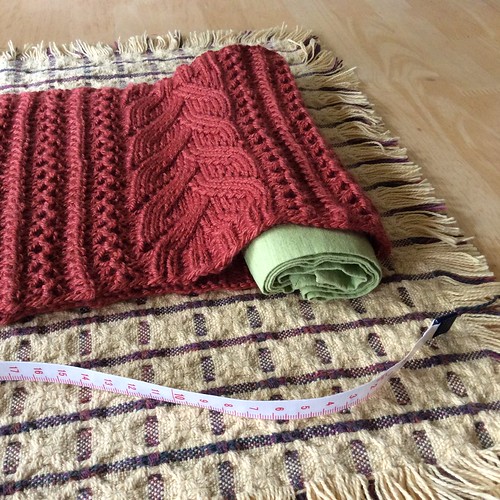Ever since I published Bluet last spring, I've wanted to make another in a fall color. So that's what I cast on for the Blue Peninsula Neckwear KAL, and I'm so glad I did. Knit in a lush blend of wool and silk, it's beautifully soft against the skin, and the color is perfect, too.
Pattern: Bluet, by Bonnie Sennott
Yarn: Stitch Sprouts Yellowstone (80% wool, 20% silk) in the Caldera colorway
Needle: US 4/3.50mm
This was my first time knitting with Yellowstone, a new DK weight wool/silk blend from Stitch Sprouts. With a brand-new yarn, you never know how things will go—but from my first swatch, I fell in love. Yellowstone knits up beautifully, producing even stitches that look perfect even before blocking. It's got great stitch definition, and the silk content gives the fabric a subtle, satisfying luster.
My first Bluet used around 425 yards (nearly all of two skeins) of Louet Gems Sport, so when the Yellowstone arrived, I wound up both skeins right away. But, this new Bluet used just under one skein—about 270 yards. The difference in yardage was surprising, but the good news is I have a full skein of Yellowstone left. So I've decided to give it away, along with a copy of the pattern.
Have you got a favorite way to block cowls or other projects knit in the round? To block Bluet, I gave it a soak in Eucalan and water, then let it dry on a towel. I used a rolled-up dinner napkin on each end and shifted it every few hours, like a scroll or a conveyor belt, so that creases didn't form.
For a chance to win this skein of Yellowstone and the Bluet pattern, just leave a comment about your favorite method of blocking by midnight EST, Friday, October 3. I'll use a random number generator to select the winner. Be sure to leave your Ravelry username or email, so I know how to contact you.
Good luck!








83 comments:
I've blocked cowls by giving them a good spraying,lying them flat on a towel, and shifting them around as you did.
Beautiful pattern and yarn! Thanks for the giveaway!
teabird on Ravelry
I usually soak my cowls in wool wash, lay them flat, and rotate them periodically to prevent creases.
Beautiful cowl in such gorgeous yarn! Thank you for the generous giveaway!
I think I do it the same as other folks, soak, wrap in towel and step on, then lay flat, beat it with my palm and shape, then rotate a few times as it dries.. :)
Most of the items that I've knit and blocked have been flat and I've soaked them in water, roll them in a towel to get excess water out, then pin out on the guest bed and let them dry. I hae also steam blocked a couple of items.
lyndeepitiak on Ravelry
I always wet block with some Soak wash, squeeze gently to get some water out, then roll up in a towel (and usually step on the towel a little, which my kid really likes to help with!), then lay it out on my blocking mats. I pin it out if it needs that, otherwise I just lay it flat. I really like your idea of rolling up a mat or towel and using that to avoid creases for a cowl!
I like to put rolled-up towels inside the cowl to block.
I really love the color of this yarn, and have loved it as you've been knitting on your cowl.
I use SOAK for my knitted items then after gently squeezing the water out in a rolled up towel, I lay them flat and change every so often to prevent creases. I'm glad you posted about using dinner napkins in each end of the cowl and roll it that way, as I always have some crease.
Thank you for the giveaway.
I generally wet block & if it is lace use blocking wires...I find these helpful to evenly stretch the lace.
I recently watched a finishing class by Anne Hanson showing a new to me way to steam block using a wet towel & hot iron I want to try.
pbtajr on Ravelry
Gorgeous pattern, would love to win.
Thanks for the chance.
I've soaked, steamed, and sprayed. All with pins, but I bought blocking wires and hope to use them soon. I think my life will be easier and the items will come out without bumps.
I block cowls by soaking them an a wool wash first. Then, I roll them in a towel to get out excess moisture. I gently place both ends around 2 liter bottles of pop, moving them around every couple of hours until dry. No creases!
I usually soak, then debate whether to use blocking wires or just lay it flat. Usually the blicking wires lose.
I've not blocked anything knitted in the round yet. Love the pattern and the yarn. Also love the ideas on blocking something in the round.
I've always laid flat and rotated periodically, but I LOVE the rolled up towel/napkin idea for preventing creases. Will definitely try ito n my next project!
I soak in Woolite, and take out excess water with towels. I block using pads and pins, I will now try the towel and dinner napkin routine. Love it!!
This is a wonderful cowl with a great combination of stitches. I also love this color of yarn.
I'm usually a naughty, naughty knitter who doesn't block right off the needles. After I wash my knits, I use a microfiber chamois instead of towels, as it pulls more water out. Rather than laying out items like cowls or scarves, I hang them by putting padded hangers spaced every 6 or 8 inches, then laying the item across the bars so no part droops very much, shifting the item occasionally. I'm not fanatic about crisp, straight edges and pointy corners.
I usually SOAK mine, squeeze out the water and then roll in a towel and step on it (Like most of the others have said). If its lace is try to pin it out but other then that just lay it flat and then move it so as not to have creases as it dries. LOVE this cowl by the way :)
I soak in cold water, roll in a towel, step on the towel (fun part) then either 1. Lay out on blocking mats until partially dry then rotate around so it won't crease until dry. Or 2. Lay out on blocking mats with towels rolled up on either end of cowl to prevent creases (like you did in picture).
My method of blocking a cowl is the same as what you did. Such a beautiful pattern and gorgeous color of yarn. I sure could use a joy of winning something these days. Thank you for the opportunity to enter.
I like a warm bath with Unicorn wool wash, good rinse and a roll in the towel. I use empty paper towel rolls covered with hand towels, then roll as necessary to prevent wrinkles. Love this color way and the pattern. Thanks
The only way I've ever blocked is to gently wash or wet the item, lay it out on my blocking boards and pin while stretching every so slightly to make it even on the sides.
I like to give it a warm little bath with soak, squish the water out, and block it with a couple of water bottle covered hand towels at each end. Thanks for the chance for the win; I will definitely be putting your cowl on my queue if I am not the lucky winner.
-seestephyknit on Ravelry
To block, I first soak then use two pieces of pvc pipe, long enough for the width of the cowl, on each end. Then I stretch and rotate from side to side until dry. Or sometimes I just soak and pull into place and let dry. I absolutely love the yarn and pattern used on your cowl.
What a great idea for blocking a cowl! I'll have to try it. I usually lay flat.
Thanks for the giveaway!
I'm so bad at blocking cowls, I usually just lay them flat and rotate so they don't get any creases!
I usually just lay flat spray with wather and pin. works for me
I usually block my knitted items with a light spray and lay out on ironing board. I then use a doublt towel and finish with a steam iron to shape item.
I usually wet block -I still haven't worked with a fiber which did not block well with a bath and some stretching! (I usually feel better after that treatment as well) :)
--stellacometa on Ravelry
I've mostly knit scarves or shawls...which are flat and do not present a problem. Anything in the round, I do have to keep rearranging to keep them from creasing. I do wash everything before blocking. I figure it releases extra color from the yarn and any dirt or hand oils from knitting.
I usually dampen the item & roll in a towel followed by laying out to size & pinning, or else spritz heavily after pinned down. I often use my ironing board as a base, but recently got some of the rubbery puzzle pieces for a more mobile method.
Sue.
Wow, such a lot of great blocking methods that I haven't tried! I usually soak in wool wash and block the cowl flat, pinned out on my blocking board. If the cowl only needs light blocking I'll steam it.
I love using a steamer for fast blocking when I want to wear the cowl right away. Otherwise I will soak and lay out to desired measurements.
For cowls such as this, I wet block, squeeze out excess moisture and then use cardboard paper towel rolls between the top and the bottom, rolling the whole thing along several times during the drying process.
finnknitter on Ravelry
I actually have a bit of a problem blocking cowls. I just block as I normally do a scarf, but doubled over. The end result always leaves a fold crease - not so great. So live reading all the methods here!
My Rav name is wildwoolly
Most of the items that I've knit and blocked have been flat
Which I've soaked them in water, roll them in a towel to get excess water out, then pin out on the
form puzzle pieces and let them dry.
Purplefrog5 on Rav
Most of the items that I've knit and blocked have been flat
Which I've soaked them in water, roll them in a towel to get excess water out, then pin out on the
form puzzle pieces and let them dry.
Purplefrog5 on Rav
After a soak, I just roll in a towel squeeze, then flatten out
Usually squish in a towel than flatten out.
My method is basically the same as yours, but without the towels - I'm going to have to steal that idea!
I also use Soak instead of Eucalan, but that's largely just habit at this point.
Soak in Eucalan and water then place in towel and step on it to get out as much water as possible pin to blocking mat. Once dry I steam out any creases left in blocking.
I like the lavender or grapefruit soak and then pin it out. I am a pretty aggressive blocker..
I LOVE blocking -- for cowls I soak in tepid water with lavender Eucalan, gently pour out the soaking water and refill the basin with fresh water at the same temperature, and give a gentle swish. Then I gently squeeze, roll in a towel and squeeze again, and then lay it out on a towel on my blocking pads. Then I visit it whenever I walk by, rotating it each time and moving it to a dry spot on the towel, and realigning any edges, so it dries completely. (I also nuzzle and sniff the wooly loveliness frequently, but I don't think that step is critical.)
For cowls, after a soak I put in two big oatmeal containers...they are the size of big tomato juice cans, but they're made of paper. Then I just roll the cowl along the towel on the table to dry evenly. Much faster than doing it flat I've found. Thanks for the chance to win such lovely yarn!
I follow the SOAK, roll in towel and "dance" method before putting my item on the blocking mats. Previously, I just pinned my cowls flat, but I like your method much better! Thanks for the chance to win the lovely pattern and yarn.
Almost all of my blocking involves hand-washing and gently rolling in a towel to remove excess moisture. I like to slip a wooden dowel through a cowl and then prop each end of the dowel on a chair back or kitchen stool. This allows the cowl to dry more quickly without much fussing. (ckknit on Ravelry)
I soak a cowl in the sink, rinse, roll up in a towel then pin it out on a fresh, dry towel. When it's close to dry but not quite, I loop it around a chair back. thanks for the sweet giveaway!
(Knittingpessimist on ravelry) - I pretty much do what every one else does soak - squeeze wrapped in a towel - wait a couple hours unroll and lay flat and gently shape - the cowl looks like a lovely pattern and the yarn looks wonderful as well - thanks for the giveaway!
I find that a proper soak and simple blocking works beautifully on my cowls. I love how fluffy and fresh they feel once they're dry. I love your Bluet pattern and I especially love seeing it in this beautiful color.
Mist...and Move...repeat! Seems to work!
Thanks for the fun!
Yhime407 on Ravelry
I always wet block, but haven't done a cowl yet. I like the ideas I have seen here about putting a rolled towel or napkin inside and moving it around to avoid creases. Love your pattern!
I wet block most things since I don't have a steamer. Just let sit in warm water with some wool wash, gently squeeze water out, then shape and lay flat. I'd love to get a good steamer one day, too.
I block by soaking in Soak and then laying out or pinning on to interlocking blocking boards. I've only done 1 cowl and used cut pool noodles to hold up the edges at the folds. I rotated once through air drying and it worked great. No seams or folds! ravelry-jennknitfer
I think we all pretty much do the same thing, but I have just learned a few tricks by reading through the previous comments. I always give my knits a good soaking for at least an hour, then squeeze as much water out before I roll it up in the towel and step on it a few times. I then lay it out on my blocking mats and pin if necessary. I use a hand towel wrapped around the cardboard from a paper towel roll at the edges of a cowl to prevent creasing.
Ravelry ID: 1maineknitwit
I like to give my knitting a good soak, roll excess water with a towel, lay it out on a table and pin or shift as needed to accommodate the pattern. FannyKaplan on Ravelry
I do the same unless it gets steam blocked. Gorgeous color!
I wash with Eucalan, then (if it's small enough) I pin my knitted item onto the sofa cushion. I move it around the house depending on where the kids and animals are, so no one messes with it. :)
Rav ID: SaraMCrafts
I've never blocked anything. So I'll be looking to learn that, especially as I'm finishing up my first knitted scarf! Thanks for the ideas, Bonnie!
I always let it soak first for about 20 minutes at least - longer if I forget about it - and I recently blocked a tam around a dinner plate and it worked really well. I know, not a cowl...........
I soak it for about 20 to 30 minutes, press out most of the water with my hands. Then I lay it flat on a thick towel and roll the towel up. Then I step on it to press out more water. Then I unroll the towel and lay the cowl on a blocking mat and pin it out.
The next day I will unpin it and turn it over and repin it if it needs it. After that if it still is completely dry, I will turn the cowl inside out and lay it out to finishing drying.
I like to block smaller cowls and things around cans of soup and rotate to avoid a crease!
Hi,
Thanks so much for the chance to win this... I'm just around the corner in north Amherst, so if I win we can meet for coffee...?
I usually pin block most things our on my bed, but I have been known to block hats on dinner plates!?
I tend to leave it to soak for half an hour, then squeeze gently in a towel, then lay out on a towel across my bed. If needed, I use crochet cotton and pins to create straight edges.
Very interesting about the different yardages necessary. As I looked at this Bluet, it looks much airier, lighter. I'm assuming the gauge was the same, or you would have mentioned the modification. This one is quite lovely; I like the way it came out very much.
I have used a small styrofoam noodle to keep the folded ends from getting a crease. Good to hear what others are using for a wool wash. I found some by Kookaburra (I think), and like it very much. I keep meaning to try Soak.
My preference for blocking a cowl is to soak thoroughly, use towels to blot until just damp, pin out worth towels rolled in sides so no creasing. Sometimes I'm so excited to wear the cowl I don't block it ;)
The design is absolutely beautiful! The variety of pattern stitches in the cowl make a beautiful overall design. I love it!!
I use Ivory Snow and hand soak and then lay in a towel to get extra water out and then put the item on a clean net with air vents underneath and a towel under that.
My blocking method is similar to yours Bonnie. I use Eucalan for soaking my knits, roll in a towel, and lay out to dry on blocking squares. I use light weight canisters from my protein drinks to prevent creases in my cowls. They are easy to rotate and seem to help the knits dry faster.
I love Bluet and the Yellowstone yarn in Cardera is beautiful. Thanks for the lovely giveaway.
Bordergirl on Ravelry
I only have one lace cowl that needs blocking in the round and I have to confess to date I've just lived with the creases at the sides. I'll have to try your trick next time I block it.
I usually steam block them, but I just learned a lot by reading the comments. Can't wait to try some of the other ways.
I pop my FOs into a Soak bath to relax, then lay them out (normally on the spare bed) with a few towels to cushion them until they dry! This is so generous, thank you.
I use my set of blocking wires and those padded floor blocks to lay out my project once I soak in in wool wash and roll it in a towel.
I soak with a wool wash product then block outside on my screened porch. Love this pattern!
I haven't steam blocked or anything. I usually soak my project, dry it most of the way with a towel and then pin it on some mats (that are interlocking work out mats I got on sale awhile back) :)
Pattern is beautiful, yarn is too. :)
Thanks for the technique tip. I'll try it out on my next cowl!
Since I mainly work with either cottons or acrylics, blocking is more or less a "steaming" event. I carefully pin sections to the ironing board pad and steam, remove pins, repeat. Sometimes I will cover with a towel and press up/down...not IRONing. I would love to win...cowls are a fav. of mine! MollyMable (kbgodwin@charter.net)
What a beautiful pattern which is lovely in this lush drapy yarn which enhances the textured design.
Love the pattern.
Spray and pinned my items.
Purplefrog5 on rav
Beautiful cowl! I usually soak in Euclan, roll up in a towl to remove excess liquid, lay it on mats and shape and pin. I love your method to avoid creases!
Garretli on Ravelry
Soak in tepid water, smoosh the water out, wrap loosely in towel, and pin on another dry towel.
skillinworkshop on rav
I haven't blocked anything knit in the round yet. I'm glad to see the ideas of how to do that. For items not knit in the round, I have just spritzed with water, then patted the item into place or else used blocking wires, depending on what it looks like it needs.
After a lukewarm Eucalan bath, I squeeze the cowl in a bath towel and lay on my foam blocking squares, if it is long, or, if it fits, on my mesh sweater dryer. I move it around from time to time to help it dry and avoid creases. Debbieamy on Ravelry
I usually spray and then pin the item into place as needed.
Love this pattern :-)
kcdemott on Ravelry
Post a Comment